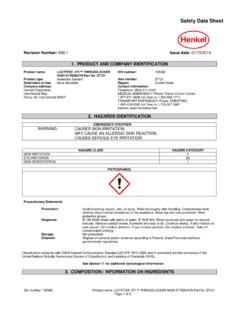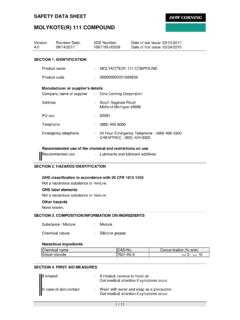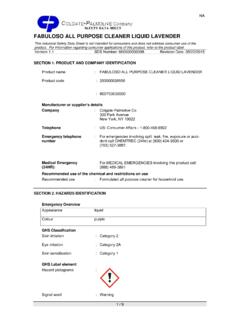Transcription of SAFETY DATA SHEET Lubricating Oil - Hoppes
1 Revision date: 2/8/2019 Revision: 7 Supersedes date: 10/9/2017 SAFETY data SHEETL ubricating OilAccording to Appendix D, OSHA Hazard Communication Standard 29 CFR IdentificationProduct identifierProduct nameLubricating OilChemical nameProcess OilProduct number1003, 1003B, 1003RB, 1003 CNInternal identification1000-202 CAS number64742-54-7 Recommended use of the chemical and restrictions on useApplicationFirearm LubricationUses advised againstNo specific uses advised against are of the supplier of the SAFETY data sheetManufacturerBushnell Holdings Inc9200 CodyOverland Park, KS telephone numberEmergency telephoneEmergency Telephone Number (Hazardous Material/Dangerous Goods TransportationEmergency Only) 1-800-424-9300 (Inside US Only)
2 +01-703-527-3887 (Outside US) -(CHEMTREC, Day and Night)2. Hazard(s) identificationClassification of the substance or mixturePhysical hazardsNot ClassifiedHealth hazardsNot ClassifiedEnvironmental hazardsNot ClassifiedLabel elementsHazard statementsNC Not ClassifiedOther hazardsThis substance is not classified as PBT or vPvB according to current EU Composition/information on ingredientsSubstancesProduct nameLubricating OilChemical nameProcess OilCAS number64742-54-74. First-aid measuresDescription of first aid measures1/8 Revision date: 2/8/2019 Revision: 7 Supersedes date: 10/9/2017 Lubricating OilGeneral informationIf in doubt, get medical attention promptly. Show this SAFETY data SHEET to the specific recommendations.
3 If throat irritation or coughing persists, proceed as affected person to fresh air and keep warm and at rest in a position comfortable forbreathing. Loosen tight clothing such as collar, tie or belt. Get medical attention if anydiscomfort specific recommendations. If throat irritation or coughing persists, proceed as mouth. Get medical attention if any discomfort ContactNo specific recommendations. Rinse with water. Get medical attention if any contactRemove any contact lenses and open eyelids wide apart. Rinse with water. Get medicalattention if any discomfort of first aidersUse protective equipment appropriate for surrounding important symptoms and effects, both acute and delayedGeneral informationThe severity of the symptoms described will vary dependent on the concentration and thelength of specific symptoms known.
4 Spray/mists may cause respiratory tract specific symptoms known. May cause discomfort if contactNo specific symptoms known. May cause contactNo specific symptoms known. May be slightly irritating to of immediate medical attention and special treatment neededNotes for the doctorTreat treatmentsNo special treatment Fire-fighting measuresExtinguishing mediaSuitable extinguishing mediaThe product is not flammable. Extinguish with alcohol-resistant foam, carbon dioxide, drypowder or water fog. Use fire-extinguishing media suitable for the surrounding extinguishingmediaDo not use water jet as an extinguisher, as this will spread the hazards arising from the substance or mixtureSpecific hazardsContainers can burst violently or explode when heated, due to excessive pressure combustionproductsThermal decomposition or combustion products may include the following substances:Harmful gases or for firefightersProtective actions duringfirefightingAvoid breathing fire gases or vapors.
5 Evacuate area. Cool containers exposed to heat withwater spray and remove them from the fire area if it can be done without risk. Cool containersexposed to flames with water until well after the fire is out. If a leak or spill has not ignited, usewater spray to disperse vapors and protect men stopping the protective equipmentfor firefightersWear positive-pressure self-contained breathing apparatus (SCBA) and appropriate protectiveclothing. Standard Firefighter's clothing including helmets, protective boots and gloves willprovide a basic level of protection for chemical date: 2/8/2019 Revision: 7 Supersedes date: 10/9/2017 Lubricating Oil6. Accidental release measuresPersonal precautions, protective equipment and emergency proceduresPersonal precautionsNo specific recommendations.
6 For personal protection, see Section precautionsEnvironmental precautionsAvoid discharge into drains or watercourses or onto the and material for containment and cleaning upMethods for cleaning upReuse or recycle products wherever possible. Absorb spillage to prevent material contaminated area with plenty of water. Wash thoroughly after dealing with a of contents/container in accordance with national to other sectionsFor personal protection, see Section 8. For waste disposal, see Section Handling and storagePrecautions for safe handlingUsage precautionsRead and follow manufacturer's recommendations. Wear protective clothing as described inSection 8 of this SAFETY data SHEET . Keep away from food, drink and animal feeding all packages and containers carefully to minimize spills.
7 Keep container tightly sealedwhen not in use. Avoid the formation of on generaloccupational hygieneWash promptly if skin becomes contaminated. Take off contaminated clothing and washbefore reuse. Wash contaminated clothing before for safe storage, including any incompatibilitiesStorage precautionsStore away from incompatible materials (see Section 10). No specific classUnspecified end uses(s)Specific end use(s)The identified uses for this product are detailed in Section Exposure Controls/personal protectionControl parametersOccupational exposure limitsLong-term exposure limit (8-hour TWA): OSHA 5 mg/m Long-term exposure limit (8-hour TWA): ACGIH 5 mg/m Short-term exposure limit (15-minute): ACGIH 10 mg/m OSHA = Occupational SAFETY and Health = American Conference of Governmental Industrial controlsProtective equipment Appropriate engineeringcontrolsNo specific ventilation protectionNo specific eye protection required during normal use.
8 Large Spillages: Eyewear complyingwith an approved standard should be worn if a risk assessment indicates eye contact date: 2/8/2019 Revision: 7 Supersedes date: 10/9/2017 Lubricating OilHand protectionNo specific hand protection recommended. Large Spillages: Wear protective skin and bodyprotectionWear appropriate clothing to prevent repeated or prolonged skin measuresWash after use and before eating, smoking and using the toilet. Do not eat, drink or smokewhen using this protectionNo specific recommendations. Provide adequate ventilation. Large Spillages: If ventilation isinadequate, suitable respiratory protection must be exposurecontrolsNot regarded as dangerous for the Physical and Chemical PropertiesInformation on basic physical and chemical propertiesAppearanceClear pointNot boiling point and range315 C/599 FFlash point192 C/378 FEvaporation rateNo information (solid, gas)Class IIIB LiquidUpper/lower flammability orexplosive limitsNot pressure< mm Hg @ 25 CVapor density> g/ccRelative lb/galSolubility(ies)Insoluble in coefficientNot temperature210 C/410 FDecomposition TemperatureNot wt (Max)10.
9 Stability and reactivityReactivitySee the other subsections of this section for further at normal ambient temperatures and when used as recommended. Stable under theprescribed storage of hazardousreactionsNo potentially hazardous reactions date: 2/8/2019 Revision: 7 Supersedes date: 10/9/2017 Lubricating OilConditions to avoidThere are no known conditions that are likely to result in a hazardous to avoidNo specific material or group of materials is likely to react with the product to produce ahazardous decompositionproductsDoes not decompose when used and stored as recommended. Thermal decomposition orcombustion products may include the following substances: Harmful gases or Toxicological informationInformation on toxicological effectsToxicological effectsNot regarded as a health hazard under current toxicity - oralNotes (oral LD )Based on available data the classification criteria are not toxicity - dermalNotes (dermal LD )Based on available data the classification criteria are not toxicity - inhalationNotes (inhalation LC )
10 Based on available data the classification criteria are not corrosion/irritationAnimal dataBased on available data the classification criteria are not eye damage/irritationSerious eye damage/irritationBased on available data the classification criteria are not sensitizationRespiratory sensitizationBased on available data the classification criteria are not sensitizationSkin sensitizationBased on available data the classification criteria are not cell mutagenicityGenotoxicity - in vitroBased on available data the classification criteria are not on available data the classification criteria are not carcinogenicityNone of the ingredients are listed or toxicityReproductive toxicity - fertilityBased on available data the classification criteria are not toxicity -developmentBased on available data the classification criteria are not target organ toxicity - single exposureSTOT - single exposureNot classified as a specific target organ toxicant after a single target organ toxicity - repeated exposureSTOT - repeated exposureNot classified as a specific target organ toxicant after repeated hazardAspiration hazardBased on available data the classification criteria are not date: 2/8/2019 Revision: 7 Supersedes date: 10/9/2017 Lubricating OilGeneral informationNo specific health hazards known.





